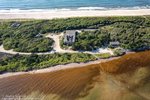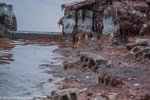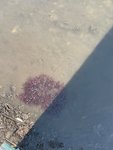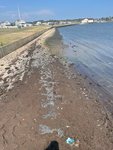




It can only be described as a raw sewage smell with a hint of sea. South Patchogue residents, especially those located near the Davis Park Ferry Terminal, are complaining, largely on social media, about the horrible smell filling the air on hot, dry days—which comprised most of the summer.
Is it the hot weather or sewage?
According to Patchogue Village officials, they have had the Suffolk County Department of Health and the village’s Department of Public Works scout the location to ensure the smells were not emerging from the sewage system. At times when there are strong odors near the bay, the staff has also checked the area near the northern wastewater treatment plant, where no odors were found. However, nothing is malfunctioning. Instead, the village attributed the smells to the high temperatures and lack of rain.
While down at the Brightwood Street ferries, Davis Park Ferry owner Stephanie Sherman agreed that the smells weren’t from sewage. Instead, she said she thought it was a rotting seaweed smell.
“It is some sort of strange seaweed. It’s brownish-red and it has only recently been here; we don’t know where it came from,” she said. “It’s everywhere.”
She said she can smell it on the Davis Park side as well, though, she laughed and said she has become accustomed to it by now.
Nearby restaurant Drift 82 owner John Sarno affirmed the smell, noting, “It smells like yesterday’s diapers.”
Fortunately, he said, the winds have kept the odors minimal at his business; however, it is something he definitely doesn’t want his patrons subjected to. He hopes the New York State Department of Conservation resolves the issue as soon as possible.
But this is not just an isolated issue. The odors are popping up in bayside locations across the South Shore, including the neighboring hamlet of Blue Point, where councilman Neil Foley said residents are complaining as well.
“The Town of Brookhaven is well aware of the odor. This is caused by a lack of rain, heat, and strong southwest winds,” Foley stated. “The Parks Department is removing seaweed as fast as they can. The issue should resolve itself in a couple of weeks. We will continue to monitor and clean the beaches until it subsides.”
Even South Shore residents as far as the Village of Brightwaters have been victim to the smells. Mayor John Valdini confirmed the reports, noting that residents most noticed the smell and red, murky waters near Gilbert Park, the beach area that’s farthest into the bay in the village.
So, where is the smell coming from?
According to Save the Great South Bay, they have called on their colleagues at Stony Brook University School of Marine and Atmospheric Sciences, who are looking into the issue. Robyn Silvestri, executive director of SGSB, said it could be the seaweed or it could be the red tide again like last year. (A red tide is an event that occurs on the coastline when algae—a plant-like organism—grows out of control. Additionally, red tides often cause a rotting smell, also a very sulfurous scent, although no visible red, murky waters were seen on foot by the Patchogue marina or the ferries.)
Either way, the solution is to stop the nitrogen pollution in the bay through connecting homes and businesses to sewers rather than cesspools, she said, noting residents can also upgrade to innovative and alternative on-site wastewater treatment systems (IA/OWTS). Grants are available through Suffolk County. Another contributing factor, she added, is landscaping fertilizers.
“Nitrogen pollution in the bay triggers algal blooms. Our organization diligently advocates for municipalities, businesses, and homeowners to reduce the nitrogen load coming from the mainland by connecting to sewers, updating outdated cesspools, and reducing—or better yet, eliminating—the use of chemical-laden fertilizers,” said Silvestri.
What is the red seaweed?
The recent Japanese red seaweed invasion at Heckscher State Park had Save the Great South Bay supporters on high alert, Silvestri wrote on the SGSB website. The seaweed is an invasive seaweed from Japan first detected on Long Island waterways three years ago and has now spread to the point of being “everywhere.” The seaweed, according to SGSB, becomes a health hazard and releases hydrogen sulfide gas when it decays. It can also be harmful to marine life.
The New York State Department of Conservation has also received reports of various macroalgae (seaweed) and eelgrass washing up and decomposing along Long Island’s shore. Dasysiphonia japonica is an invasive alga that has a major presence in the Great South Bay and was first reported in New York in 2018, the NYSDEC explained.
“This particular algal species is associated with large red masses and a sulfur smell when decaying. It prefers cooler water temperatures, and the recent high temperatures likely have contributed to the increased die off,” a NYSDEC spokesperson explained.
Like many other types of algae and organic matter, when decomposing it can emit hydrogen sulfide gas after it washes up and decays on the shore. More details about health effects can be found here: https://www.health.ny.gov/environmental/chemicals/hydrogen_sulfide/.
HOW TO FIND HELP:
To report suspicious marine algal blooms in Suffolk County, please use the following online form to submit to Suffolk County Department of Health Services: https://survey123.arcgis.com/share/0b53ed8ca4144e3ca38233e6e2ab508e
For observations of dead fish, crabs, or shellfish along the shores, please report it to the DEC Marine Life Incident Report online survey: https://survey123.arcgis.com/share/c4a0ad629d9d464495f81802f2e4b768 or call at 631-444-0714.
Comments
No comments on this item Please log in to comment by clicking here